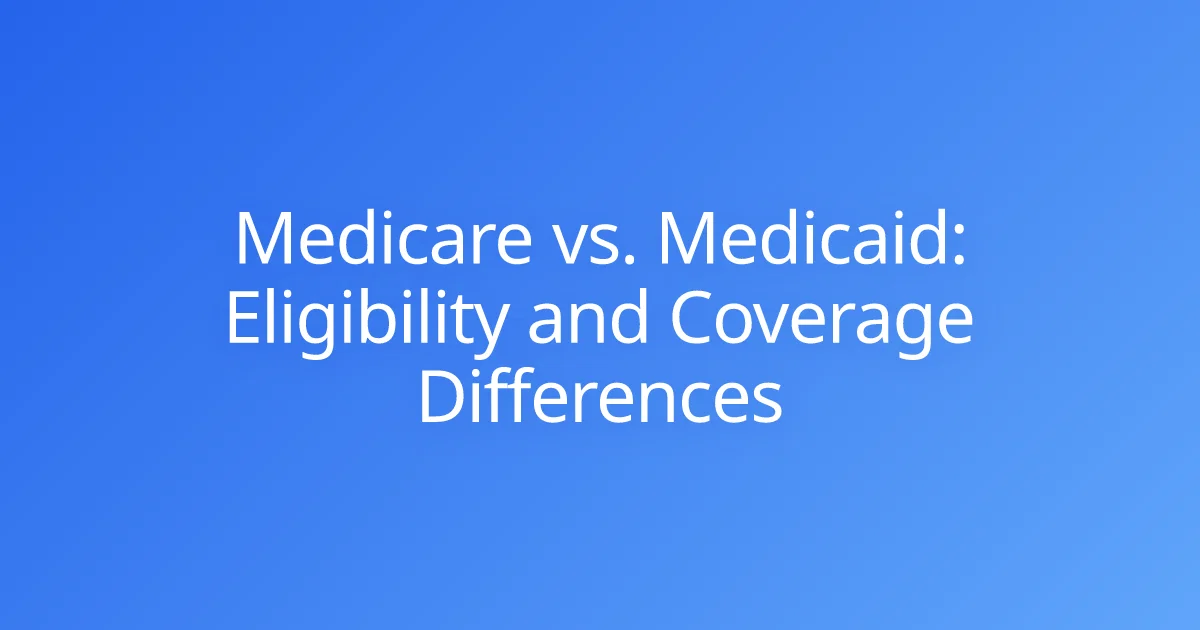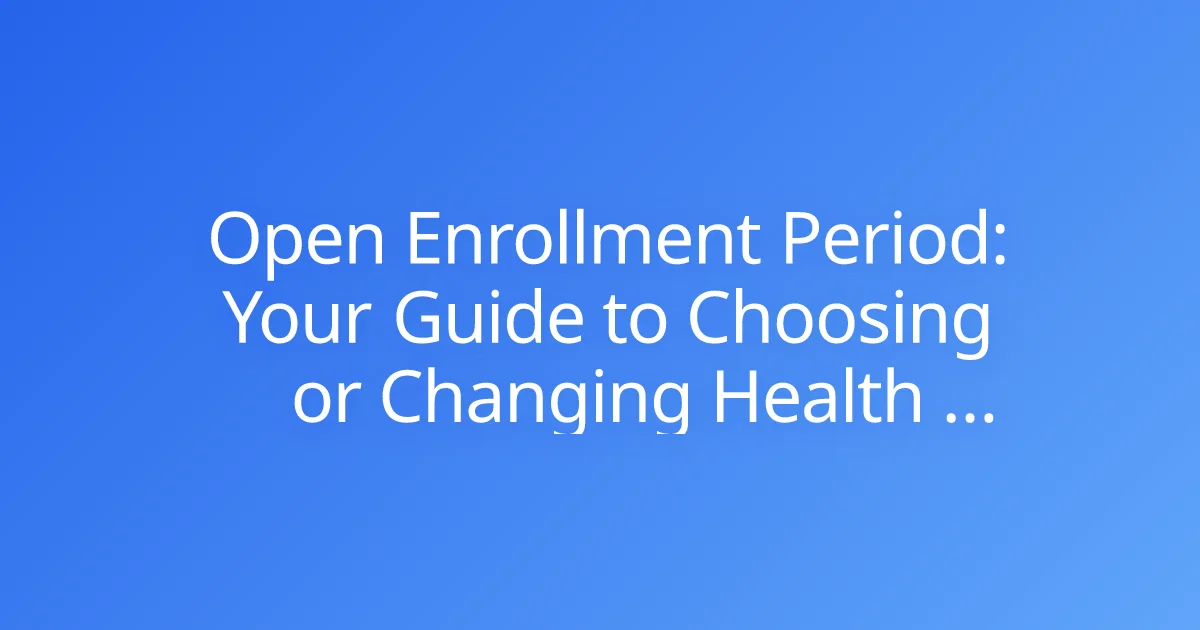Medicare vs. Medicaid: Eligibility and Coverage Differences
When it comes to understanding healthcare in the United States, two terms often cause significant confusion: Medicare and Medicaid. While both are vital government-funded health insurance programs, they serve vastly different purposes, cater to distinct populations, and have unique eligibility requirements and coverage scopes. Many people mistakenly use these terms interchangeably, leading to misunderstandings about their own potential benefits or those of loved ones.
This comprehensive guide will precisely define Medicare vs. Medicaid, breaking down their eligibility rules, detailing the specific coverage each provides, and highlighting their key differences. Our goal is to clarify these complex programs, empowering you with the accurate knowledge you need to navigate the healthcare system for yourself, your family, or your community.
Understanding Medicare: Health Insurance for Seniors and the Disabled
Medicare is a federal health insurance program primarily designed for people aged 65 or older. However, it also covers certain younger individuals with specific disabilities and people with End-Stage Renal Disease (ESRD - permanent kidney failure requiring dialysis or a transplant) or Amyotrophic Lateral Sclerosis (ALS).
Unlike income-based programs, Medicare eligibility is largely tied to age, work history, and specific health conditions.
Who is Eligible for Medicare?
Most U.S. citizens and legal residents (living in the U.S. for at least five years) become eligible for Medicare when they turn 65 if they or their spouse paid Medicare taxes through employment for at least 10 years (40 quarters). This grants them premium-free Part A.
Even if you haven't worked long enough, you may still be able to get Medicare by paying premiums for Part A. Additionally:
- Under 65 with certain disabilities: Individuals who have received Social Security Disability Insurance (SSDI) benefits for 24 months are automatically enrolled.
- End-Stage Renal Disease (ESRD): People of any age with ESRD are eligible.
- Amyotrophic Lateral Sclerosis (ALS): Individuals of any age with ALS are eligible immediately upon disability benefit approval.
The Four Parts of Medicare (A, B, C, D)
Medicare is structured into distinct parts, each covering different types of healthcare services.
Medicare Part A (Hospital Insurance)
This part covers inpatient hospital stays, care in a skilled nursing facility, hospice care, and some home health care. Most people don't pay a monthly premium for Part A if they or their spouse worked and paid Medicare taxes for at least 10 years.
Medicare Part B (Medical Insurance)
Part B covers doctor's services, outpatient care, durable medical equipment, and some preventive services. Most people pay a monthly premium for Part B, which is often deducted directly from their Social Security benefits. There is also an annual deductible and usually 20% coinsurance for most services after the deductible is met.
Medicare Part C (Medicare Advantage)
Medicare Part C, also known as Medicare Advantage, is an alternative way to receive your Medicare benefits. These plans are offered by private insurance companies approved by Medicare. They must cover everything that Original Medicare (Parts A and B) covers, but they often include additional benefits like dental, vision, hearing, and prescription drug coverage (Part D). You typically pay a monthly premium for a Medicare Advantage plan, in addition to your Part B premium.
Medicare Part D (Prescription Drug Coverage)
Part D is voluntary prescription drug coverage, offered by private insurance companies approved by Medicare. It helps cover the cost of prescription drugs and is available to anyone with Medicare Part A and/or Part B. Part D plans usually involve a monthly premium, an annual deductible, and copayments or coinsurance for prescriptions.
What Medicare Does NOT Cover (Key Gaps)
While comprehensive for many medical needs, Original Medicare has notable coverage gaps:
- Long-term care: Such as nursing home care or assisted living.
- Routine dental care: Including dentures.
- Routine eye exams and eyeglasses.
- Hearing aids and fitting exams.
- Cosmetic surgery.
- Acupuncture.
- Routine foot care.
These are common reasons why many Medicare beneficiaries consider supplemental plans (Medigap) or Medicare Advantage plans to cover these gaps.
Understanding Medicaid: Health Coverage for Low-Income Individuals
Medicaid is a joint federal and state program that provides health coverage to millions of Americans, primarily those with low incomes. It serves a diverse population, including children, pregnant women, parents, seniors, and individuals with disabilities.
Unlike Medicare, Medicaid eligibility is primarily determined by income and family size in relation to the Federal Poverty Level (FPL), and it varies significantly from state to state.
Who is Eligible for Medicaid?
Eligibility for Medicaid is complex because each state operates its own program within federal guidelines. However, common eligibility groups include:
- Low-income families and children.
- Pregnant women.
- Individuals with disabilities.
- Seniors (especially those with low income and few assets, who may also have Medicare).
States that have expanded their Medicaid programs under the Affordable Care Act (ACA) also provide coverage to nearly all non-elderly adults with incomes up to 138% of the Federal Poverty Level. In states that have not expanded, eligibility for adults without children or a qualifying disability is often much more limited.
What Does Medicaid Cover? (Mandatory vs. Optional Benefits)
Federal law mandates that states cover certain "mandatory" benefits under Medicaid, ensuring a foundational level of care. These include:
- Inpatient and outpatient hospital services.
- Physician services.
- Lab and X-ray services.
- Nursing facility services for individuals aged 21 or older.
- Home health services.
- Early and Periodic Screening, Diagnostic, and Treatment (EPSDT) services for children under 21.
- Family planning services.
- Rural health clinic and Federally Qualified Health Center (FQHC) services.
States also have the option to cover a wide range of "optional" benefits, which can include:
- Prescription drugs.
- Dental care.
- Vision care.
- Physical and occupational therapy.
- Mental health services.
- Non-emergency medical transportation.
The inclusion and extent of these optional benefits vary significantly by state.
Medicaid's Role in Long-Term Care
Medicaid is the primary payer for long-term care services in the United States, including nursing home care and home and community-based care for eligible low-income seniors and individuals with disabilities. For many families, Medicaid becomes a critical lifeline when long-term care becomes necessary, as Medicare does not cover these costs.
Medicare vs. Medicaid: A Direct Comparison (Key Differences)
To solidify your understanding, let's directly compare the fundamental distinctions between these two critical programs.
| Feature | Medicare | Medicaid |
|---|---|---|
| Primary Purpose | Health insurance for seniors (65+) and certain younger people with disabilities. | Health coverage for low-income individuals and families. |
| Funding Source | Federal government, primarily through payroll taxes. | Joint federal and state government funding. |
| Eligibility Criteria | Primarily age (65+), work history (paid Medicare taxes), or specific disabilities/diseases. | Primarily income and asset levels (based on Federal Poverty Level), with state variations. |
| Scope of Coverage | Primarily acute medical care (hospital, doctor visits, drugs). | Broader range of services, including long-term care and often more comprehensive benefits like dental/vision (state dependent). |
| Cost-Sharing | Involves premiums (Part B, D, C), deductibles, copayments, and coinsurance. | Generally low or no premiums, deductibles, or copayments for beneficiaries. |
| Administration | Federal program, administered by the Centers for Medicare & Medicaid Services (CMS). | Administered by individual states within federal guidelines. |
Dual Eligibility: When You Qualify for Both
It is indeed possible, and common, for individuals to qualify for both Medicare and Medicaid. These individuals are referred to as "dual eligible" or "Medi-Medi" beneficiaries. This typically occurs when a person aged 65 or older (or who meets Medicare disability criteria) also has very low income and limited assets, making them eligible for Medicaid.
How Medicare and Medicaid Work Together
For dual eligible individuals, Medicaid acts as the secondary payer to Medicare. This means:
- Medicare pays first: Medicare covers services first as it normally would.
- Medicaid picks up the rest: Medicaid then pays for costs not covered by Medicare, such as Medicare premiums (Part B, Part D), deductibles, copayments, and coinsurance.
- Additional Benefits: Medicaid can also cover services not covered by Medicare at all, such as long-term care in a nursing home or certain dental and vision services, depending on the state's Medicaid program.
This coordination significantly reduces out-of-pocket healthcare costs for dual eligible individuals, providing them with comprehensive and affordable coverage.
Choosing the Right Path: Important Considerations
Understanding the differences between Medicare and Medicaid is crucial, whether you're planning for retirement, assisting an aging parent, or facing unexpected changes in your employment or health status.
- Assess Your Eligibility: Start by determining if you meet the age/disability requirements for Medicare or the income/asset limits for Medicaid. Remember to check your specific state's Medicaid rules.
- Consider Your Healthcare Needs: Do you anticipate needing long-term care? Do you have significant prescription drug costs? These factors will influence which program, or combination of programs, best suits your situation.
- Explore Enrollment Periods: Be aware of Medicare's initial enrollment periods around your 65th birthday or disability effective date. For Medicaid, enrollment is generally open year-round for those who qualify.
- Seek Guidance: Navigating these programs can be complex. State Health Insurance Assistance Programs (SHIPs) and local Medicaid offices can provide personalized guidance.
Conclusion
Medicare and Medicaid are foundational pillars of the U.S. healthcare system, each playing a distinct yet vital role in providing access to medical care. Medicare primarily serves the elderly and specific disabled populations, with eligibility based on age and work history. Medicaid, on the other hand, is a needs-based program providing coverage for low-income individuals and families, with eligibility and benefits varying by state.
Knowing the nuanced differences between Medicare vs. Medicaid is not just academic; it's essential for making informed decisions about your health coverage and financial well-being. By understanding which program applies to whom, you can better plan for your future healthcare needs or help others access the benefits they rightfully deserve.
Do you have more questions about how these programs might apply to your unique situation?



